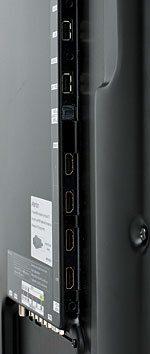Samsung UN55B7000 LCD TV Page 2
The Samsung has two USB inputs that you can use to play back photos, music, and video (even HD video) that’s recorded in a compatible format. DLNA is also available to play back material that’s stored on your computer through your home network.

A feature called BD Wise lets a compatible Samsung disc player talk to the set and automatically optimizes a number of operating parameters. For example, it can determine which component—the player or the set—will do a better job in video processing the source, and then it will automatically set the player’s output resolution accordingly.
While the Samsung’s onscreen menus are good, I have some minor quibbles. The most significant of these is that they time out too fast, which can be a significant problem when you’re trying to calibrate the gray scale and color space. While you’re making individual calibration adjustments, the menus for each setting are at the bottom of the screen where you can see them, but they’re out of the way of the measuring device. But before you can complete the measurement, those menus time out and you return to the previous full-screen menu that blocks the instrument.
 Poetry in Motion?
Poetry in Motion?
The Samsung UN55B7000 is a 120-hertz set, which means it operates at a refresh rate of 120 Hz. If the source is film based and transferred at 1080p/24, the Samsung repeats each frame four times to bring the source up to 120 Hz—for 5:5 pulldown. According to Samsung, if the set receives a film-based source other than 1080p/24—say, 1080p/60 with 3:2 pulldown—it recognizes this, converts it to 24 Hz (by eliminating the 3:2 pulldown), and again repeats frames to reach the display’s 120-Hz refresh rate. If the source is not film based, the display repeats frames as needed for a 120-Hz refresh.
Like all 120-Hz sets I know of, the Samsung offers frame interpolation to reduce motion lag. Samsung’s name for this feature is Auto Motion Plus 120Hz. When it’s switched on, the set interpolates the added frames rather than simply repeating them.
This process offers several operating modes. The Custom mode provides an interesting option. It has separate, adjustable controls for Judder (for film-based material) and Blur (for video sources). You can set these so that film-based sources are processed only for blur. This leaves the motion characteristics of film intact while still smoothing motion on video material. It also helps alleviate my main issue with frame interpolation: making filmed material look like video. Nevertheless, I did not use Auto Motion Plus 120Hz in this review.
The Samsung lets you watch Internet TV through the Yahoo! Widget Engine for services like stock monitoring, photo sharing, news, and weather. To use this feature, you need a direct connection to the Internet via an Ethernet cable to your modem or a wired or wireless connection through your home network. The available Internet widgets appear to be more limited than the widgets that are offered on a Panasonic HDTV we reviewed recently (the TC-P46G10, HT, July 2009), but it’s likely that Samsung will add more later.
Two Samples
I had two samples of the Samsung. The first worked fine for a few days, but its picture soon turned an odd, bluish color that was accompanied by severe, noise-like artifacts. It was obviously defective. Samsung sent me a second sample, but that one’s HDMI audio didn’t work consistently. I didn’t request a third set; the second one’s video performance, my main concern here, was fine.

When the set’s audio was working, its quality was adequate but below average for a flat-panel display. If you use an external sound system, this won’t matter. However, be sure that your system has lip sync (audio delay)—good advice with any new digital display. Most video processing delays the image long enough to produce a small but annoying audio/video disconnect. This isn’t usually an issue with the set’s own sound because the design provides a fixed delay to compensate for it. However, subsequent experience indicates that these two problems were limited to early production samples that will be history by the time this review hits the streets.
Video Processing and Stuff
The Samsung sailed through nearly all of my video processing tests (both standard definition and high definition), with minor exceptions. In the Auto1 Film mode, it passed all of our HD 3:2 pulldown tests (1080i to 1080p), but in Auto2 mode it did not. It failed the HQV Benchmark SD (480i to 1080p) mixed-content test (a video scroll over a filmed background) in Auto1 and passed it in Auto 2. In both settings, it scored well above average—though not perfect—in an SD 2:2 test that pans and zooms across a small garden lattice (a test that most displays fail badly), although it did slightly better at it in Auto2. However, with most material, you’re unlikely to see any significant difference between the two Auto settings.
The Samsung reproduces above white and below black. In its Screen Fit mode (not available for SD sources or 720p component), it produced a precise 1:1 pixel map, with no cropping. The Warm2 Color Tone setting was much more accurate than we usually see on sets out of the box. While I watched the set in this state for much of the testing (with no real complaints about its color), the following comments reflect my observations after a full calibration.
Aziz, LEDs!
In most LCD sets, the backlighting is positioned behind the LCD panel with a diffuser that provides relatively uniform illumination across the screen. In early sets with LED backlighting, the LEDs simply substituted for the more common cold cathode fluorescent (CCFL) backlights.
- Log in or register to post comments





























































